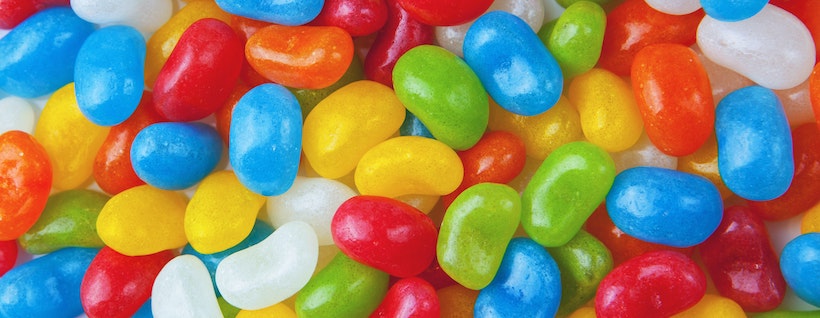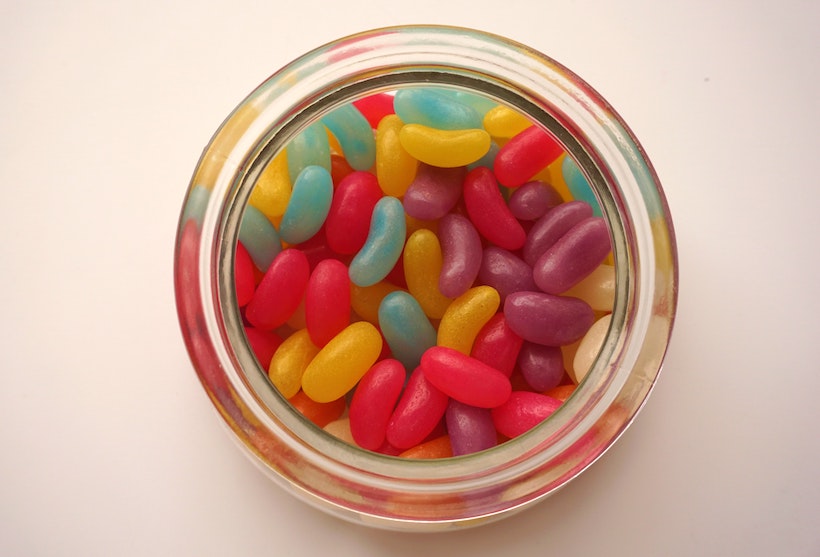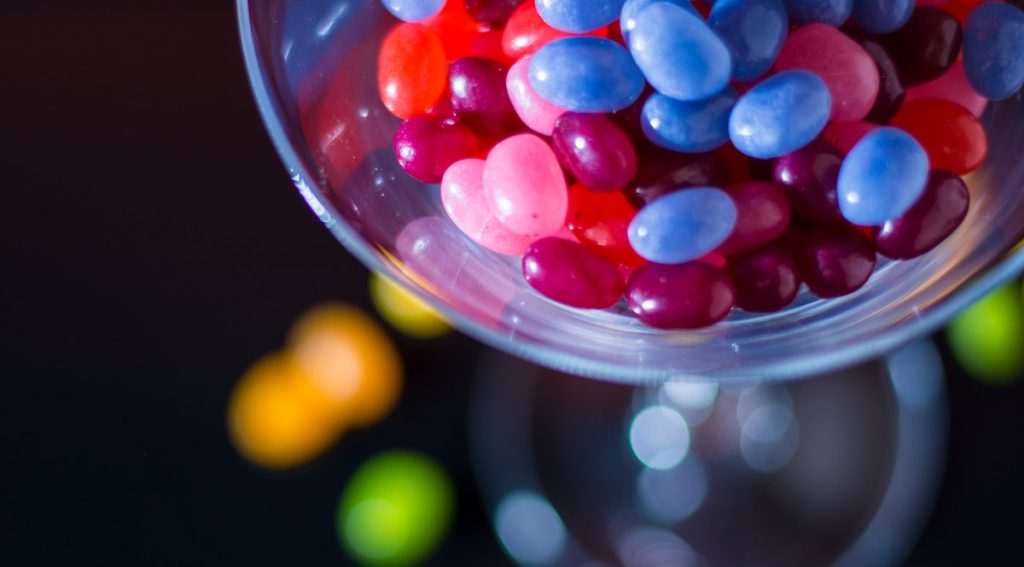Oh, jelly beans... that classic candy seen in Easter baskets and candy jars worldwide. This hugely popular candy has become such a part of popular culture that it makes you wonder about its origins.
Interestingly, even though jelly beans originated in America, we don't know their full history. Let's take a look at what we do know in this guide to the history of jelly beans.

If you're not up to speed on confectionary goodies, jelly beans are hard-shelled candies with a chewy center. They get their name from their bean-like shape and come in over 50 flavors, such as:
Manufacturers make jelly bean centers using sugar, flavoring, and a binder such as pectin, then coat it with a hard candy shell using a process called panning. Panning involves building multiple thin layers of a syrupy sugar mixture and letting the layers harden.
A small serving of jelly beans has about 40 calories, 8 grams of sugar, and no fat.
No one knows for sure exactly why jelly beans are bean-shaped. We've got theories, though, chief among them:
A classic bean is a little on the larger side. However, when Jelly Belly beans came out in the 1970s, they featured smaller beans than traditional jelly beans.
Do you love jelly beans? If so, you're not alone—if all the jelly beans eaten last year were placed end to end, they would circle the globe over five times. A few more interesting facts on the beans:
Unlike other Easter treats (such as hot cross buns, which have been around for thousands of years), jelly beans have only been around since the 1800s. But in that short amount of time, they've gone from a humble penny candy to one enjoyed by presidents and astronauts.
Although jelly beans' full history is unknown, confectionary historians generally agree that they're a combination of two sweets that have been around for centuries: Turkish delight and Jordan almonds.
Turkish delight, called "lokum "in Turkey, is a chewy candy made with gel, sugar, and a range of flavors like lemon, rosewater, and hazelnut. This candy is usually cubed and covered in powdered sugar.
Many attribute the invention of Turkish delight to a confectioner named Bekir Effendi, although there is no proof to back this up. Regardless, this sweet treat has been around at least since the late 1700s.
Turkish delight is still widely enjoyed in the Middle East – and across the globe – today.
Jordan almonds are sweet and savory, containing a whole almond coated in a sugar shell.
People have been celebrating special occasions with Jordan almonds since ancient Roman times when the almonds were honey-coated. As sugar became more widely available in the 1400s, the coating eventually morphed into the one we know today.
Jordan almonds are still immensely popular, often being used to celebrate special occasions such as weddings.

Legend has it that the first mention of jelly beans in print was Boston candy manufacturer William Schrafft's advertisement encouraging people to send jelly beans to Union soldiers during the Civil War. This hasn't been substantiated, however.
By 1905, jelly beans were mentioned (and documented) in the Chicago Daily News and included in Webster's dictionary, so they've likely been around since the late 1800s.
Penny candy is a term that originated in the mid-1800s for inexpensive candy that was sold in bulk rather than per piece. Although it priced per pound, they usually ended up costing around a penny per individual candy.
Because jelly beans most likely came into being in the mid or late 1800s, they arrived just in time to enjoy the popularity of penny candy as sweet shops became more common across America. They were convenient candies to store in bulk – jelly beans don't melt or stick together.
There is no clear reason why jelly beans have become associated with Easter, although the association became commonplace in the 1930s. The popularity of including these candies in Easter baskets is probably a combination of:
● Their egg-like shape
● Their inexpensive price point
● Their ability to travel without making a mess
Regardless of who initially thought to add jelly beans to the Easter holiday, the tradition isn't likely to die out soon.
In 1869, Gustov Goelitz opened the Herman Goelitz Candy Company in Cincinnati, focusing on candy corn. In 1913, Gustov's brother Herman moved to California and opened the Goelitz Confectionery Company.
In 1976, David Klein partnered with the Herman Goelitz Candy Company to improve their existing jelly beans, add natural flavors, and add flavor to the inside of the candy, rather than just the shell. He named the modified candy Jelly Belly – purportedly after the musician Lead Belly (Huddie William Ledbetter) – and it became immensely popular.
Klein promoted the candy doing tours while dressed as "Mr. Jelly Belly," adding to the candy's success, and then sold his rights to the Herman Goelitz Candy Company in 1980.
In 2001, the Herman Goelitz Candy Company and the Goelitz Confectionery Company merged, rebranding as the Jelly Belly Candy Company. To this day, about 80% of their sales are jelly beans, although they also manufacture chocolate, gummies, licorice, and more.
You know a candy is well known when it makes its way into popular culture. If you look at the number of references to jelly beans in American pop culture, you'll see why it's hard to imagine life without the candy.
By 1915, jelly beans had made their way into the common vernacular, and "jelly bean" became a slang term for an attractive yet shallow or weak person. F. Scott Fitzgerald even used the term as a short story title.
In 1964, The Beatles received an unpleasant introduction to the hard-shelled candies when fans pelted the band with jelly beans at a show. Fans had learned that the band liked Jelly Babies, a softer UK candy, and mistakenly thought they were the same thing, resulting in an irate George Harrison asking them to stop.
Jelly beans aren't just popular among jazz-age authors and pop stars. President Ronald Reagan loved the little candies and ate them to do something while he quit smoking. Jelly Belly even created a blueberry-flavored jelly bean especially for him, although he much preferred the licorice flavor.
Reagan enjoyed the candy so much that he gave some to astronauts aboard Challenger in 1983. The crew caught them in their mouths as they floated in space, delighting news audiences worldwide.
Jelly beans are also commonly used in jelly bean guessing games, in which players must guess how many jelly beans are in a glass jar or other clear container. The closest to the answer wins a prize.
This game is popular at office raffles, fairs, and children's birthday parties.

Aren't jelly beans fun? We don't really know their whole history; it seems like jelly beans have just been there with us for a long time.
So next time you pop some jelly beans in your mouth, think about the fun facts we do know – there may be no more quintessential Easter treat than the humble jelly bean.